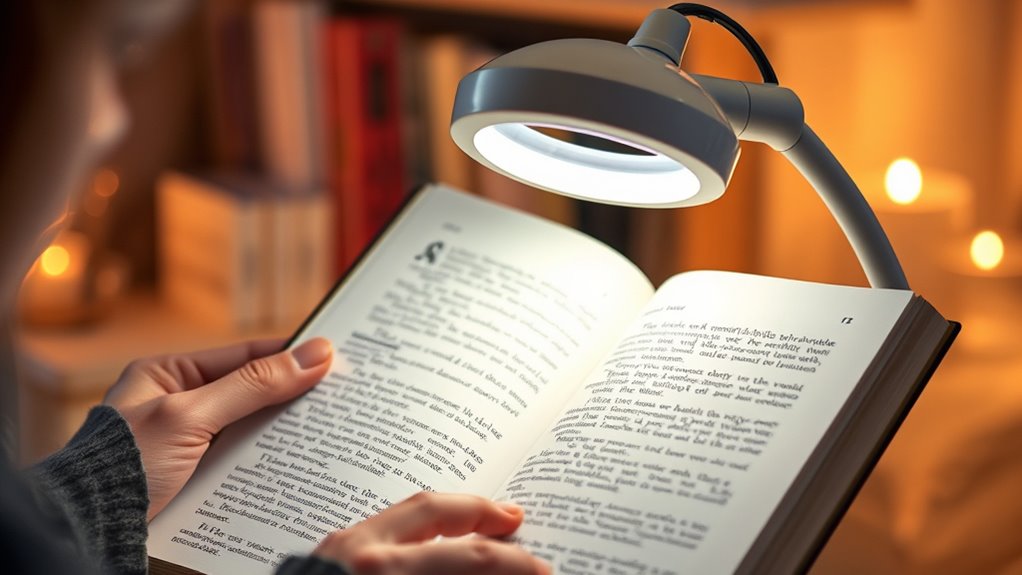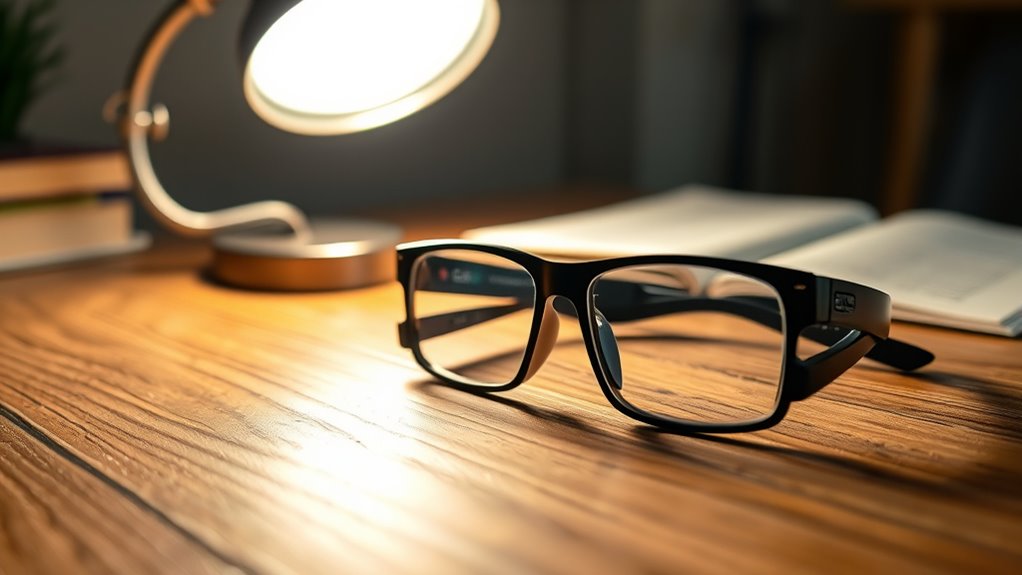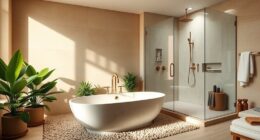To improve your vision, consider using magnification devices like handheld or electronic magnifiers to see small details clearly. Pair these with adjustable, bright lighting that reduces shadows and glare, making objects easier to distinguish. Using high-contrast colors in your environment can also help navigation. Combining these strategies enhances visibility and independence. Keep exploring different tools and techniques to find the best solutions for your specific needs.
Key Takeaways
- Use various magnification devices, such as handheld and electronic magnifiers, to enhance visual clarity for near tasks.
- Optimize lighting with bright, adjustable, and focused sources to reduce shadows and improve contrast.
- Incorporate high-contrast colors and environment adjustments to facilitate easier object recognition and navigation.
- Combine lighting and vision aids to maximize visibility and independence in daily activities.
- Select personalized solutions based on individual needs, preferences, and specific visual challenges.

Have you ever wondered how people with low vision can navigate daily life more easily? It all comes down to smart use of vision aids and lighting solutions that enhance their remaining sight. One of the most effective strategies involves optimizing color contrast. By adjusting colors around you—such as choosing high-contrast combinations like black text on a white background or bright yellow signs on dark backgrounds—you make objects and text stand out more clearly. These simple visual tweaks can considerably reduce confusion and make reading labels, recognizing faces, or finding everyday items much easier. Color contrast isn’t just about aesthetics; it’s a practical tool that helps you distinguish between objects quickly and accurately, especially when your vision is limited. Incorporating HEPA filtration into the environment can also improve air quality, reducing allergens and irritants that might affect low vision individuals with sensitivities. Magnification devices are another essential aid for those with low vision. These tools range from handheld magnifiers to electronic devices that enlarge text and images on screens. Using magnification devices allows you to see details that might otherwise be blurry or indistinguishable. For instance, a handheld magnifier can help you read small print on medication bottles or grocery labels, while digital magnifiers with adjustable zoom can be used to examine intricate crafts or read detailed instructions. The key is selecting the right magnification device for your needs—some people prefer simple hand-held options, while others might benefit from more sophisticated electronic magnifiers that offer adjustable magnification levels and enhanced lighting. These devices don’t just improve visual clarity; they empower you to perform daily tasks independently and with confidence. Incorporating proper lighting is equally essential. Bright, well-directed light reduces shadows and enhances the effectiveness of color contrast and magnification aids. Adjustable lighting options, such as task lamps with variable brightness levels, let you tailor illumination for specific activities. For example, bright, focused lighting on your reading materials can make a notable difference, especially when combined with high-contrast colors and magnification devices. Avoiding glare and ensuring even lighting prevents visual discomfort and fatigue, making tasks more manageable. When your environment is well-lit and thoughtfully arranged, it complements your vision aids, creating an accessible space that minimizes frustration and maximizes independence. Ultimately, combining these strategies—leveraging color contrast, using appropriate magnification devices, and optimizing lighting—can dramatically improve your ability to navigate your environment. Each element works together to compensate for low vision, allowing you to maintain your independence and engage more fully with your daily activities. With the right tools and adjustments, you can make your world clearer and more manageable, even when your eyesight isn’t perfect.
Frequently Asked Questions
Can Low Vision Aids Be Customized for Individual Needs?
Yes, low vision aids can be customized to meet your individual needs. Manufacturers offer various customization options, allowing you to select features like magnification levels, contrast settings, and ergonomic designs. This guarantees the aid fits comfortably and effectively addresses your specific vision challenges. By tailoring these aids, you get a personalized solution that enhances your daily activities and improves your quality of life.
Are There Any Affordable Lighting Solutions for Low-Income Users?
Imagine finding a lighthouse’s beam guiding you safely through fog—affordable lighting solutions can do that for low-income users. Yes, there are low-cost lighting options like LED lamps and adjustable reading lights that fit tight budgets. These affordable options provide bright, focused illumination, helping you see better without breaking the bank. You don’t need expensive gear; simple, effective lighting can make a big difference in your daily life.
How Do I Choose the Best Vision Aid for My Condition?
You should consider your specific vision needs when choosing a vision aid. If you need magnification for reading small print, try magnifying glasses or electronic readers, which are adjustable and easy to use. Think about your daily activities and comfort. Test different options if possible, and consult with an eye care professional to find the best fit for your condition. This way, you’ll pick a device that improves your vision effectively.
What Maintenance Is Required for Different Vision Aids?
Think of your vision aids as loyal garden plants that need daily care. You’ll need to regularly clean devices with gentle wipes to keep them shining like new. For electronic aids, check batteries often and replace them as needed—think of it as fueling a car for smooth rides. Proper maintenance guarantees your aids stay reliable, helping you see clearly and confidently every day.
Are There New Technological Advancements in Low Vision Lighting?
Yes, there are exciting advancements in low vision lighting. Smart lighting systems now adapt in real-time to your environment, enhancing visibility and reducing eye strain. Wearable devices, like smart glasses, incorporate integrated lighting that adjusts based on your needs, providing targeted illumination. These innovations make it easier to see clearly, improve safety, and boost independence, offering personalized solutions that seamlessly integrate into your daily routine.
Conclusion
Believe it or not, the right lighting and vision aids can truly transform your daily life. Some experts suggest that enhancing your environment might even stimulate remaining vision, boosting confidence and independence. While no solution is perfect, combining proper lighting with tailored aids could make a noticeable difference. So, don’t underestimate how small adjustments can have a big impact—your eyes might just surprise you when given the right support.









